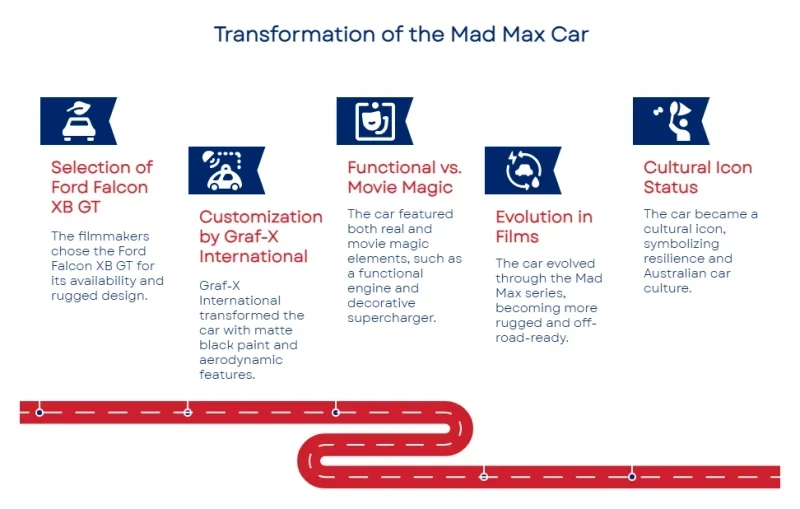The Birth of an Icon: How the Mad Max Car Came to Life
If you’ve ever wondered what the Mad Max car was, it’s a heavily modified 1973 Ford Falcon Interceptor Fury, with a story as gritty and powerful as the films themselves. Driven by Max Rockatansky, this iconic vehicle roared across the desolate Australian outback, becoming as legendary as the man behind the wheel.
I remember the first time I saw it on screen, matte black paint shimmering like coal under a dying sun. You couldn’t take your eyes off it. It felt less like a car and more like a beast ready to tear the world apart.
What You’ll Learn
Coming up in this post, you’re going to get answers to three big questions about the Mad Max car that fans and gearheads alike still ask today:
How a stock Australian muscle car became the menacing Pursuit Special.
What worked under the hood, and what was pure movie magic?
Why this car became a lasting cultural icon.
Summary
The Mad Max car is one of the most recognizable movie vehicles of all time: a brutal, post-apocalyptic machine that began life as a humble Australian muscle car. Fans love it for its aggressive looks, cinematic power, and gritty story. Below is a brief overview of what makes this car legendary, whether you’re interested in its film history, car specifications, or cultural impact.
Here’s a more detailed breakdown:
Why the filmmakers picked the Ford Falcon XB GT
The 1973 Ford Falcon XB GT was chosen for its availability in Australia, its rugged design, and its raw power, making it a believable police pursuit car in a collapsing world.
How the stock car was transformed into the Pursuit Special
The vehicle was customized with a matte black paint job, wide wheel arch flares, roof and boot spoilers, a Concorde-inspired nose cone, side exhausts, and the iconic supercharger, most of which were cosmetic but unforgettable.
Real vs. movie magic
While the car did have a powerful V8 under the hood, some features, like the supercharger and nitrous, were purely for show in the first film. Later versions connected the blower for real functionality.
Changes across the Mad Max films
The car evolved over the series, showing increased wear and rugged upgrades in The Road Warrior, and even became an off-road version called Razor Cola in Fury Road.
Why it remains a cult classic
It’s more than just a car; it has become a symbol of survival, rebellion, and Australian car culture. Replicas are sold at auction, while museums still display the original builds.
Other notable facts
Claimed cinematic horsepower: approximately 600 hp (fictional).
Only a handful of authentic replicas exist today.
Some replica builds have sold for six figures at auction.
The Birth of an Icon: How the Mad Max Car Came to Life
The Mad Max car wasn’t born out of thin air; it started as a solid, capable machine that just needed the right hands to reveal its full potential. Think of it like a rough diamond. The 1973 Ford Falcon XB GT already had plenty of strength and shine under its stock white paint, but it wasn’t quite the beast that would come to define an entire film franchise.
So why did the filmmakers choose the Falcon? At the time, it was one of the most affordable and available muscle cars in Australia. It was built tough enough to handle punishing roads yet stylish enough to look intimidating on screen. Its naturally wide, low stance and big 351-cubic-inch V8 engine gave it a kind of quiet menace, perfect for the dystopian setting George Miller wanted for Mad Max.
In its factory form, the car came with around 300 horsepower, a solid 4-speed manual transmission, and a look that already turned heads in the Australian streets of the ’70s. But it still looked a little too polished for the gritty, lawless world of the movie. That’s when the creative team decided to reshape it into something that looked like it belonged to the last cop standing on the edge of civilization.
The Transformation: Turning the Falcon Into the Pursuit Special
Turning a clean-cut Ford Falcon into the Mad Max car you saw barreling through the wastelands took more than paint and a few bolts. It took vision, creativity, and a little movie magic. The filmmakers wanted the car to look like desperate mechanics built it in a crumbling world, powerful yet a little unhinged. That’s how the Pursuit Special was born.
The filmmakers brought in Melbourne-based Graf-X International to customize the car under the guidance of art director Jon Dowding. Together, they imagined a vehicle that was part muscle, part menace. They stripped away anything that looked too polished and added touches that gave it its gritty personality.
Here are the standout exterior changes that gave the car its famous silhouette:
A coat of flat matte black paint gives it a stealthy, intimidating look.
A custom “Concorde” style aerodynamic front nose cone and air dam.
A Weiand supercharger poking through the hood, dramatic but non-functional in the first film.
Roof and boot spoilers for that racing edge.
Wide wheel arch flares and eight side exhaust pipes (only two worked).
Inside, they didn’t leave it untouched either. The cabin received a roll cage, ripped and worn upholstery, a large overhead console, and a few small touches to give it the appearance of something that had barely survived the collapse of society.
Every detail was designed to make the car feel like a character in its own right, not just a prop—it was a snarling machine that fit the brutal world of Mad Max.
Quick Comparison Table: Mad Max Car On-Screen vs. Real Life
Fact vs. Fiction: What Was Real and What Was Movie Magic
The Mad Max car’s power and style were unforgettable, but not everything about it was functional. Let’s break it down into what was real, what was staged for the cameras, and what changed later.
What was real
The 351-cubic-inch (5.8L) V8 engine was a real and fully functional powerhouse, producing strong horsepower for its time.
The car’s rear-wheel drive and manual transmission were stock.
Some of the eight exhaust pipes were connected and worked.
The 351-cubic-inch (5.8L) V8 engine was a real and fully functional powerhouse, producing strong horsepower for its time.
The car’s rear-wheel drive and manual transmission were stock.
Some of the eight exhaust pipes were connected and worked.
What was movie magic?
The supercharger sticking through the hood didn’t boost the engine in the first movie; it spun thanks to an electric motor controlled by a switch.
The nitrous oxide system was purely cosmetic in Mad Max (1979).
The car’s loud, aggressive exhaust note was dubbed in post-production to sound more feral.
Some of the side pipes were fake, simply added for appearance.
The supercharger sticking through the hood didn’t boost the engine in the first movie; it spun thanks to an electric motor controlled by a switch.
The nitrous oxide system was purely cosmetic in Mad Max (1979).
The car’s loud, aggressive exhaust note was dubbed in post-production to sound more feral.
Some of the side pipes were fake, simply added for appearance.
What evolved later
In The Road Warrior, the supercharger was connected directly to the engine, making it functional.
The car underwent more rugged modifications, including large fuel tanks, a weathered finish, and the removal of rear windows to better suit the increasingly harsh world.
In The Road Warrior, the supercharger was connected directly to the engine, making it functional.
The car underwent more rugged modifications, including large fuel tanks, a weathered finish, and the removal of rear windows to better suit the increasingly harsh world.
Evolution Through the Films: How the Car Changed Over Time
The Mad Max car didn’t stay the same throughout the entire series. It evolved along with the story, getting rougher, meaner, and more suited to the wasteland with each movie. Every change told part of Max’s journey, and the world was falling apart around him.
In Mad Max (1979), the car appeared as a menacing but sleek police interceptor. It still had clean lines, a glossy, matte paint finish, and most of its original parts intact. It projected an intimidating image, suggesting a professional force, though it hadn't yet succumbed to wear and tear.
By the time Mad Max 2: The Road Warrior hit screens in 1981, the car reflected the chaos of the new world. The filmmakers stripped away its polish. The paint became duller, the body was battered, and new features were added:
Large cylindrical fuel tanks are strapped to the rear.
The rear window and boot lid were removed for utility.
Weathered and rusted finishes to match the desolate setting.
The functional supercharger was finally connected to the engine.
In Mad Max: Fury Road (2015), the car returned in an even more brutal form, known as the Razor Cola. This version was a rugged, off-road-ready monster, still recognizable as the Pursuit Special but heavily modified for survival. It sat higher off the ground, wore aggressive off-road tires, and looked ready to conquer dunes as easily as highways.
The changes weren’t just for looks; they made the car feel alive, a reflection of Max’s survival instincts and the world’s decay.
Large cylindrical fuel tanks are strapped to the rear.
The rear window and boot lid were removed for utility.
Weathered and rusted finishes to match the desolate setting.
The functional supercharger was finally connected to the engine.















